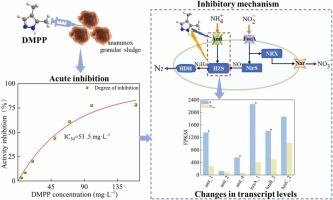厌氧氨氧化菌对3,4-二甲基吡唑磷酸盐胁迫响应机制的转录和分子模拟分析
IF 11.3
1区 环境科学与生态学
Q1 ENGINEERING, ENVIRONMENTAL
引用次数: 0
摘要
厌氧氨氧化(anammox)和硝化作用是氨氧化的两个重要生物途径,是微生物氮循环的关键。3,4-二甲基吡唑磷酸盐(DMPP)是农业土壤中常用的减少农田氮素流失的抑制剂,但其是否影响厌氧氨氧化仍是一个悬而未决的问题。急性抑制试验表明,53.5 mg·L−1 DMPP可使厌氧氨氧化菌减少50%。5 mg·L-1 DMPP处理36天后,尾注氨(亚硝酸盐)去除率从78.39(94.78)mg·gVSS−1下降到13.57(15.28)mg·gVSS−1·d−1。Kuenenia的丰度从36.5%下降到6.06%。转录组学分析显示,铵转运基因(amt_1和amt_4)和肼合酶(hzs) mRNA水平显著下调。分子对接模拟表明,DMPP与铵转运和联氨合成结合。这种相互作用阻碍了编码铵转运体和hzs基因的转录水平。该研究对减少DMPP施用下农业土壤厌氧氨氧化菌的氮流失具有指导价值。本文章由计算机程序翻译,如有差异,请以英文原文为准。

Transcriptional and molecular simulation analysis of the response mechanism of anammox bacteria to 3,4-dimethylpyrazole phosphate stress
Anaerobic ammonium oxidation (anammox) and nitrification are two vital biological pathways for ammonium oxidation, pivotal in microbial nitrogen cycling. 3,4-Dimethylpyrazole phosphate (DMPP) is commonly used as inhibitors in agricultural soils to reduce nitrogen losses from farmland, while whether it affect anammox is an open question. Acute inhibition tests revealed that 53.5 mg·L−1 DMPP caused 50 % reduction in anammox bacteria. After 36 days of prolonged exposure to 5 mg·L–1 DMPP, the ammonium(nitrite) removal rate of endnote decreased from 78.39(94.78) to 13.57(15.28) mgN·gVSS−1·d−1. Additionally, the abundance of Ca. Kuenenia decreased from 36.5 % to 6.06 %. Transcriptomic analysis revealed that the mRNA levels of ammonium transport genes (amt_1 and amt_4), and hydrazine synthase (hzs) were significantly downregulated. Molecular docking simulations indicated that DMPP bound with ammonium transport and hydrazine synthesis. This interaction hindered the transcriptional levels of genes encoding ammonium transporters and hzs. The study has guiding value to reduce the nitrogen loss involved in anammox bacteria in agricultural soils under the application of DMPP.
求助全文
通过发布文献求助,成功后即可免费获取论文全文。
去求助
来源期刊

Journal of Hazardous Materials
工程技术-工程:环境
CiteScore
25.40
自引率
5.90%
发文量
3059
审稿时长
58 days
期刊介绍:
The Journal of Hazardous Materials serves as a global platform for promoting cutting-edge research in the field of Environmental Science and Engineering. Our publication features a wide range of articles, including full-length research papers, review articles, and perspectives, with the aim of enhancing our understanding of the dangers and risks associated with various materials concerning public health and the environment. It is important to note that the term "environmental contaminants" refers specifically to substances that pose hazardous effects through contamination, while excluding those that do not have such impacts on the environment or human health. Moreover, we emphasize the distinction between wastes and hazardous materials in order to provide further clarity on the scope of the journal. We have a keen interest in exploring specific compounds and microbial agents that have adverse effects on the environment.
 求助内容:
求助内容: 应助结果提醒方式:
应助结果提醒方式:


